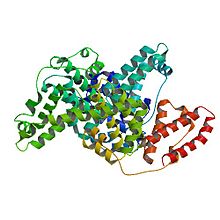Bovine serum albumin
| albumin | |
|---|---|
 |
|
| Identifiers | |
| Organism | |
| Symbol | ALB |
| Entrez | 280717 |
| HomoloGene | 105925 |
| RefSeq (mRNA) | NM_180992 |
| RefSeq (Prot) | NP_851335 |
| UniProt | P02769 |
| Other data | |
| Chromosome | 6: 91.54 - 91.57 Mb |
Bovine serum albumin (also known as BSA or "Fraction V") is a serum albumin protein derived from cows. It is often used as a protein concentration standard in lab experiments.
The nickname "Fraction V" refers to albumin being the fifth fraction of the original Edwin Cohn purification methodology that made use of differential solubility characteristics of plasma proteins. By manipulating solvent concentrations, pH, salt levels, and temperature, Cohn was able to pull out successive "fractions" of blood plasma. The process was first commercialized with human albumin for medical use and later adopted for production of BSA.
The full-length BSA precursor protein is 607 amino acids (AAs) in length. An N-terminal 18-residue signal peptide is cut off from the precursor protein upon secretion, hence the initial protein product contains 589 amino acid residues. An additional four amino acids are cleaved to yield the mature BSA protein that contains 583 amino acids.
Physical properties of BSA:
BSA has numerous biochemical applications including ELISAs (Enzyme-Linked Immunosorbent Assay), immunoblots, and . Because BSA is a small, stable, moderately non-reactive protein, it is often used as a blocker in immunohistochemistry. During immunohistochemistry, which is the process that uses antibodies to identify antigens in cells, tissue sections are often incubated with BSA blockers to bind nonspecific binding sites. This binding of BSA to nonspecific binding sites increases the chance that the antibodies will bind only to the antigens of interest. The BSA blocker improves sensitivity by decreasing background noise as the sites are covered with the moderately non-reactive protein. During this process, minimization of nonspecific binding of antibodies is essential in order to acquire the highest signal to noise ratio. BSA is also used as a nutrient in cell and microbial culture. In restriction digests, BSA is used to stabilize some enzymes during the digestion of DNA and to prevent adhesion of the enzyme to reaction tubes, pipet tips, and other vessels. This protein does not affect other enzymes that do not need it for stabilization. BSA is also commonly used to determine the quantity of other proteins, by comparing an unknown quantity of protein to known amounts of BSA (see Bradford protein assay). BSA is used because of its ability to increase signal in assays, its lack of effect in many biochemical reactions, and its low cost, since large quantities of it can be readily purified from bovine blood, a byproduct of the cattle industry.
...
Wikipedia
